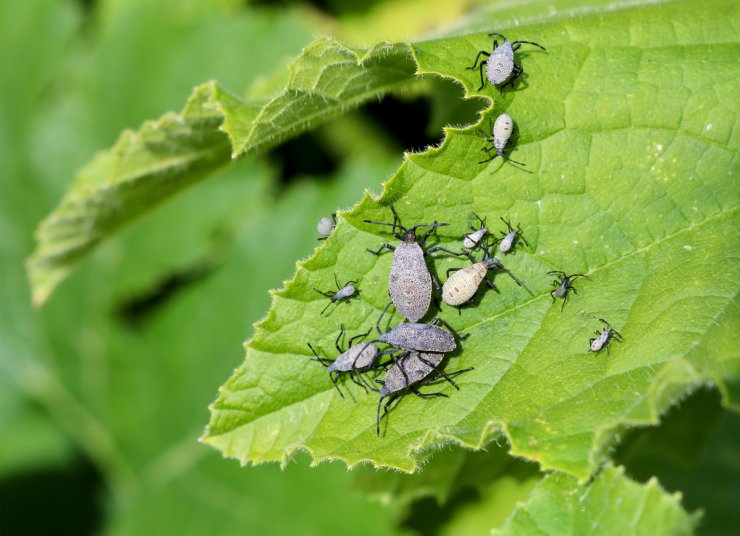
Squash bugs
Like any garden crop, both winter and summer squash are susceptible to some pests. Here are some of the critters you should look out for, checking every day (you’ll be looking for signs of disease, too).
Squash vine borers
Squash vine borers tunnel through the stems of squash plants, depriving the leaves and fruit of moisture. They are common in home gardens in the eastern half of the U.S.
Look for wilting leaves along with holes at the base of your plants that exude a green, sawdust-like substance. Once they’ve colonized a squash plant, squash borers can be hard to control. Prevention and physical controls are excellent organic methods for dealing with them.
Prevention: Plant summer squash in early July after adult borers have completed their life cycle and are finished laying eggs. Row covers can help keep squash borers off (leave them in place for only two weeks to allow for pollination), or wrap stems in foil to prevent eggs from being laid at the base of plants.
Rotate your squash crops, making sure you don’t plant them in beds where cucumbers or melons grew the previous year. Remove and destroy affected plants to prevent re-introducing borers the following year.
Physical controls: When your plants are small, sprinkle diatomaceous earth around the base of each plant. Reapply after every rain.
Try setting traps. Place a yellow bucket or bowl filled with water around your plants. Adult borers are attracted to the color yellow and will fly into the water and drown. Yellow sticky traps are also effective.
If you detect a borer in your plant, insert a wire up the plant stem to kill the larvae. You can also make a small incision in a plant’s stem to identify and remove the borers, but the plant may die. Bury any cut areas in soil to encourage rooting.
Aphids
Another common garden pest that can feast on squash plants is the lowly aphid. These invaders are prolific in many gardens and are a common sight on all kinds of food crops.
Thankfully they’re also easy to see, since they travel in colonies. Watch for a discoloration on plant stems—white, green, purple, and black are some common aphid colors.
In many cases, aphids may be eaten themselves by beneficial insects including ladybugs and wasps. That means you may not need to do anything at all if you see these helpful predators present on your plants and the infestation isn’t too extensive. Gardens containing a healthy variety of plants and healthy soil can often fend off too much damage from aphids because they attract these natural predators.
Removal: If the infestation is getting out of hand, start by spraying affected plant stems with a jet of water. Often this is enough to wipe them out.
If the situation persists, consider introducing beneficial insects such as the aphid midge and aphid wasp—excellent choices to buy for controlling aphids.
Neem oil is also effective at controlling aphids when applied according to product instructions.
Spray infestations of aphids with insecticidal soap. Try making your own by using 1 teaspoon of Dawn dish soap mixed with a spray bottle filled with water. (Be sure to rinse plants off afterwards—soap left on leaves can burn leaves exposed to sunlight.)
Pick and destroy heavily infested leaves. Again, rotate where you plant squash each year so the bugs don’t get a head start.
Squash bugs
Squash bugs attack the leaves of your plants, causing them to wither, blacken, become brittle, and eventually die. The most common squash bug is the Anasa tristis, a harmful pest that ranges throughout Central America, the United States, and southern Canada, feeding on squash, cucumber, and melon plants.
The first sign of squash bug trouble is usually brown marks on the leaves. To preempt this problem, examine the undersides of your plants’ leaves regularly. If you spot clusters of oval-shaped brown eggs, remove them. Squash bugs are known to favor larger, more mature squash plants.
Removal: They’re most active early on in the summer, so again consider using row covers at this time. Then continue to check for eggs at least twice a week. Rub or scrape off the eggs. Adult bugs can be knocked or shaken off plants into a bucket of soapy water.
You can also trap them by placing cardboard on the ground around your plants. The bugs will hide there during the day, and you can gather them up and destroy them.
Again, introducing beneficial insects such as the Trichopoda pennipes—commonly known as the feather-legged fly—if available in your area, may also help reduce squash bug numbers.
Prevention: It’s also important to clean up any spent squash plants after harvest to prevent squash bugs from overwintering in your garden.
How do you handle pests in your garden? Tell us which methods have worked best for you.


 Previous
Previous

